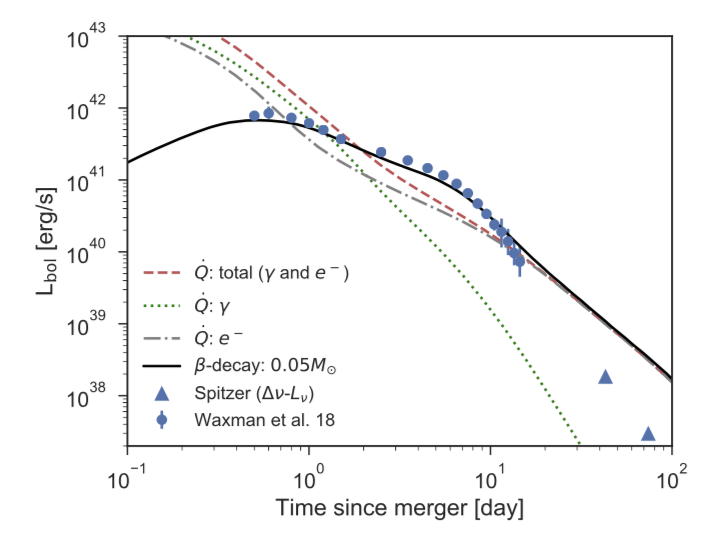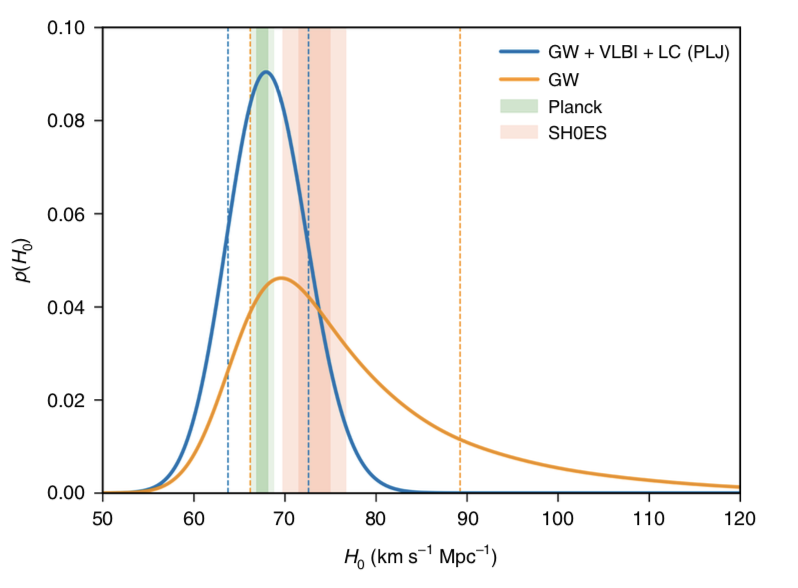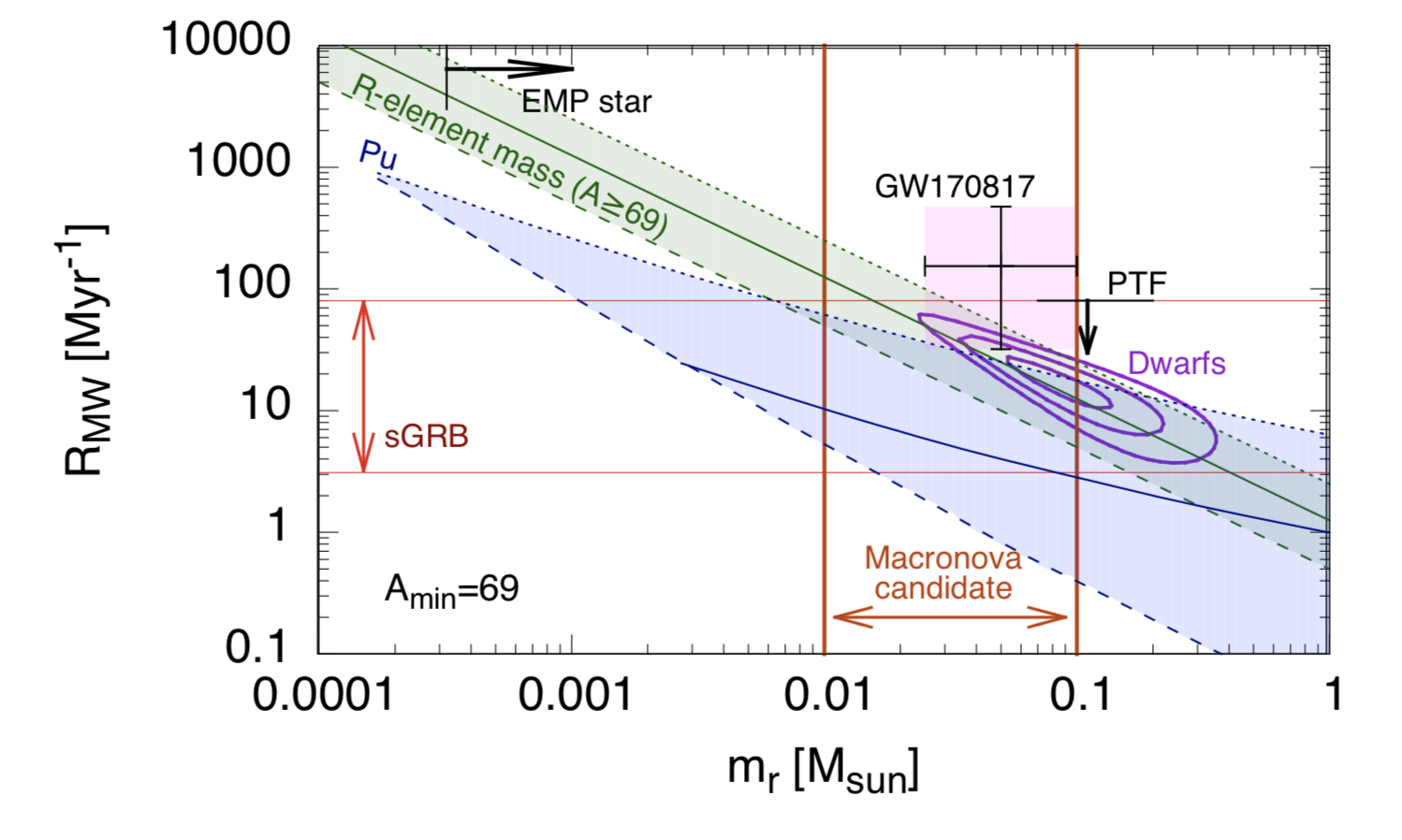Research
My research interests are in the fileds of relativity and high-energy astrophysical phenomena. I have worked mainly on theoretical studies of gravitational-wave and electromagnetic signatures from compact binary mergers. My research can be summarized as: (1) binary neutron star mergers (gravitational-waveform modelings and mass ejection), (2) kilonova/macronova , (3) radio counterparts , (4) the origin of r-process elements , and (5)the astrophysical origin of binary black holes.
1. Gravitational waves from neutron star mergers
Compact binary mergers emit enormous amounts of energy in gravitational waves. The gravitational-wave observatories have detected merger signals. Numerical relativity is the most powerful tool to compute this last moment of compact binaries. I have worked on merger simulations of binary neutron stars aiming at computing the gravitational waveforms as well as understanding the mass ejection processes and the evolution of merger remnants. I studied that the tidal effects imprinted gravitational waves and their measurability.


The evolution of the merger remnant and the amount of the mass ejection depend on the neutron star equation of state and the mass of binary. Interestingly, the several different fates of merger remnants, e.g., direct collapse to a black hole or hypermassive neutron star, are expected in a somewhat narrow range of the total mass of around 2.7Msun, which is the typical total mass of known Galactic binary neutron stars. This variety arises from a coincidence between the typical total mass and the expected maximum mass of hypermassive neutrons stars.
Please see a review article with Masaru Shibata:
2. Kilonova/Macronova

Neutron star mergers eject substantial amounts of neutron-rich material at sub-relativistic velocities.
The physical condition of this sub-relativistic ejecta is ideal for rapid neutron-capture process (r-process) nucleosynthesis. These freshly synthesized r-process nuclei radioactively decay, which continuously produces heat in the ejecta material. Such an ejecta is observed as an optical to infrared transient, a so-called "macronova" or "kilonova". Its luminosity is fainter and the evolving time scale is shorter than supernovae.
I worked on the emission properties of kilonovae with Masaomi Tanaka in 2013,
where it is shown the opacity of r-process elements is higher than that of iron group elements.
Figure (right) shows a macronova light curve and heating rates through radioactive products of beta decay of r-process nuclei (electrons and gamma-rays). Also plotted are the observed data of the macronova associated with the first neutron star merger event, GW170817. Notably, the observed luminosity roughly follows the radioactive heating rate, supporting evidence for r-porcess nucleosynthesis in neutron star mergers.
A open code for light curve modelings developed with Ehud Nakar:
3. Radio couterparts to merger events
Astrophysical explosions are often accompanied by an afterglow,
e.g., gamma-ray bursts and supernovae.
Afterglow emission has a non-thermal spectrum attributed to synchrotron radiation of relativistic electrons accelerated by the shock between a blast wave and interstellar medium (ISM).
For the typical ISM density, the afterglow of a mildly relativistic ejecta has a spectral peak around the radio region (~ 1GHz).
Neutron star mergers have been considered to produce outflows with large kinetic energy including a ultra-relativistic jet and macronova ejecta.
Radio emission produced by these outflows is of great interest as an electromagnetic counterpart to a neutron star merger.
I summarized the properties of various possible outflows and their resulting radio flare. Based on this, we also studied the detectability of radio counterparts to merger events.
I have worked on the interoperation of the radio afterglow observations
of GW170817 as a part of a collaboration, Jansky VLA mapping of Gravitational Wave bursts as Afterglows in Radio (JAGWAR). This collaboration published a series of papers including the discovery of the radio afterglow in GW170817, detailed light curve, and superluminal jet resolved by VLBI.
It is also demonstrated that resolving a superluminal motion in merger events constrains the viewing angle to the merger axis, and therefore, a Hubble constant measurement with the standard siren method can be improved with this information.


4. The origin of r-process elements
The origin of heavy elements still remains a big mystery in astrophysics. Heavy elements are considered to be produced mainly through rapid neutron capture process (r-process) and/or slow neutron capture process (s-process), where "rapid" means that neutron capture occurs on time scales much faster than beta-decay lifetimes. So the production sites of r-process elements should be environments where dense material expands rapidly such as core collapse supernovae and neutron star mergers. The left panel of the figure shows the solar abundance of r-process elements. There are three distinct peaks associated with the neutron magic numbers. Observations of metal poor stars indicate the universal abundance pattern for the elements beyond the second peak, suggestive of a single kind of astrophysical phenomena as the origin.


The right panel summarizes various astrophysical and geophysical constraints on the Galactic event rate and the amount of r-process elements produced per event. Currently, these measurements point to that the r-process events are rare, i.e., much rarer than normal core collapse supernovae. Also shown in this figure as a square is the rate and amount estimated from the first neutron star merger, GW170817. Surprisingly, these values are consistent with the other observations, and therefore, neutron star mergers seem to produce the right amount of r-process elements at the right rate. Note, however, that there are some reservations about the scenario of neutron star mergers as the main site of r-process.
A review article with Paz Beniamini and Tsvi Piran:
Press Release (08/12/2015):
Rare mergers of binary neutron stars proposed as the source of radioactive
plutonium-244 in nature.
Reaseach highlights from the jounrals of the American Astronomical Society (21/9/2016):
Colliding Neutron Stars as the Source of Heavy Elements.
5. Binary Black Holes: where they come from?
The origin of binary black hole mergers have been one of the biggest mysteries in gravitational wave astronomy since the first detection of gravitational waves. Many scenarios have been proposed including field binary evolution, dynamical capture in globular clusters, active galactic nuclei, and primordial black hole. I worked on the spin distribution of binary black hole mergers, which can be used to distinguish different scenarios.